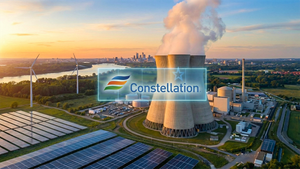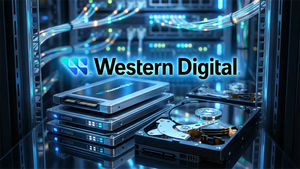
European equity markets have experienced a significant resurgence around November 20, 2025, with major indices climbing as robust company results, particularly from the technology sector, have effectively soothed widespread concerns about an "AI bubble." This upturn signals renewed investor confidence in the region's economic stability and the tangible value being generated by artificial intelligence, marking a pivotal moment after a period of market apprehension.
The rebound, which saw the pan-European STOXX 600 index gain 1% and the European technology index climb 1.8% on November 20, was largely catalyzed by stellar earnings reports. These strong performances have provided a much-needed antidote to the growing skepticism surrounding the sustainability of AI-driven valuations, suggesting that the industry's growth is grounded in solid fundamentals rather than mere speculation.
Detailed Coverage: A Market Transformed by Performance
The recent European stock market rally around November 20, 2025, was a direct response to a pivotal shift in investor sentiment, largely orchestrated by stronger-than-expected corporate earnings. This rebound followed a period of pronounced anxiety regarding an "AI bubble," which had seen European equities, particularly tech stocks, experience notable declines.
In the days leading up to the rebound, specifically between November 15 and 19, 2025, the market was gripped by a "risk-off" mood. The STOXX Europe 600 index and other major bourses repeatedly fell, with investors citing "AI bubble fears," weak economic data from China, and diminishing prospects of immediate U.S. Federal Reserve rate cuts. Tech giants like ASML Holding N.V. (AMS: ASML), SAP SE (ETR: SAP), Infineon Technologies (ETR: IFX), and Prosus (AMS: PRX) all saw their shares dip, reflecting widespread doubts about AI valuations. Volatility gauges jumped, underscoring "higher anxiety throughout the market."
The turning point arrived with the post-market close announcement on November 19, 2025, from the U.S. chipmaker Nvidia (NASDAQ: NVDA). Nvidia reported record revenue of $57 billion for its fiscal third quarter, a staggering 62% year-on-year increase, and projected an even more optimistic fourth-quarter revenue of $65 billion, significantly exceeding Wall Street's expectations. Crucially, Nvidia's CEO, Jensen Huang, directly addressed the "AI bubble" fears, stating that the "AI ecosystem is scaling fast" and that "compute demand keeps accelerating and compounding across training and inference, each growing exponentially."
This bullish outlook from a key AI industry player triggered an immediate "relief rally" across global markets, profoundly impacting European stocks. On November 20, 2025, several European companies with direct or indirect exposure to the AI and technology sectors saw substantial gains:
- ASML Holding N.V. (AMS: ASML) and Infineon Technologies (ETR: IFX) both rose 2.8%.
- Schneider Electric (EPA: SU) gained 2%.
- Siemens Energy (ETR: ENR) jumped 4%.
- French banking giant BNP Paribas (EPA: BNP) surged over 5% after announcing a new share buyback program and an increased CET1 ratio target.
- Novartis (SWX: NOVN) rolled forward its midterm sales target, citing higher expectations for key drugs.
- Halma plc (LON: HLMA), a UK-based life-saving technology company, reported record first-half results, contributing to the positive sentiment.
The initial market reactions were overwhelmingly positive, with the pan-European STOXX 600 index rising 1% and major regional bourses like Germany's DAX (ETR: DAX) and France's CAC 40 (EPA: CAC) also gaining over 1%. Nvidia's Frankfurt-listed shares jumped 6.2%, underscoring the immediate confidence boost. This widespread positive reaction was indicative of a temporary easing of investor anxiety, renewing confidence in European markets supported by improved earnings prospects.
Corporate Impact: Winners and Watch-Outs in the AI Era
The European stock rebound, fueled by strong earnings and the subsequent easing of AI bubble concerns, has created a clear distinction between potential winners and those facing significant challenges in the evolving AI landscape. Companies deeply embedded in the AI infrastructure and those rapidly adopting AI are poised for substantial gains, while those slow to adapt risk being left behind.
European Companies Poised to Win:
- Semiconductor and AI Infrastructure Enablers: These companies are the foundational pillars of the AI revolution.
- ASML Holding N.V. (AMS: ASML): As the world's leading supplier of photolithography systems for chip manufacturing, ASML is indispensable to the production of advanced AI chips. Sustained demand for AI hardware directly translates into robust orders for ASML.
- BE Semiconductor Industries (BESI) NV (AMS: BESI): Specializing in semiconductor assembly equipment, BESI benefits from the need for advanced packaging solutions for AI processors.
- VAT Group (SIX: VACN): A crucial supplier of high-vacuum valves used in chip fabrication, VAT Group stands to gain from increased capital expenditure in semiconductor manufacturing.
- ASM International (AMS: ASM): Another key player in chipmaking equipment, ASM International is closely tied to leading-edge semiconductor investments driven by AI.
- Siemens Energy (ETR: ENR): Indirectly benefiting, Siemens Energy is seeing sharply rising demand for energy infrastructure from data center operators, with a significant portion of its gas-turbine bookings attributed to AI data center power requirements.
- Smaller, specialized European semiconductor startups focusing on energy-efficient AI chips and photonic processors, such as Dresden-based FMC and France's Scintil Photonics, are attracting substantial investment, aiming to reduce Europe's reliance on foreign suppliers.
- AI-Native Software and Services Companies: These firms are at the forefront of AI application development.
- Mistral AI (Private): One of Europe's highest-valued AI startups, Mistral AI secured a substantial €1.73 billion investment in 2025, validating its foundation models and agentic AI capabilities.
- Synthesia (Private): This UK-based AI video content platform has seen significant investment, signaling strong growth in generative AI applications.
- Isomorphic Labs (Private): A DeepMind spinout leveraging AI for drug design, it announced a $600 million funding round, one of Europe's largest AI rounds.
- SaaS companies that enhance their offerings with AI are generally seeing increased spending, viewing AI as a growth catalyst.
- Industrial Companies Adopting AI for Efficiency: European industrial giants leveraging AI for operational optimization will gain a competitive edge. Companies integrating AI for predictive maintenance, quality control, supply chain optimization, and process automation in manufacturing are set to benefit.
European Companies Facing Challenges or Potential Losses:
- Legacy Software Firms with Slow AI Integration: Companies that fail to rapidly integrate AI into their core offerings or adapt their business models face significant headwinds.
- SAP SE (ETR: SAP): While acknowledging the long-term AI opportunity, SAP has faced pressure to demonstrate clear, integrated AI strategies, with its cloud business outlook impacted by trade tensions and a weaker US dollar.
- Other established software providers like Sage Group (LON: SGE) and Dassault Systèmes (EPA: DSY) have seen stock declines as the market re-evaluated AI-driven growth narratives, indicating investor demand for clearer AI integration strategies.
- A significant majority (94%) of European marketing organizations were still lagging in Gen AI maturity as of November 2025, suggesting that companies failing to advance their Gen AI capabilities risk an "AI reckoning" and efficiency disadvantages.
- Companies Not Adopting AI Effectively Across Operations: Businesses struggling with large-scale AI implementation, data quality management, or workforce upskilling will fall behind. Many European manufacturing firms face hurdles in AI adoption, including skills shortages and high investment costs. A "two-tier" pattern of AI adoption is emerging, where digitally native startups embrace AI deeply, while many established enterprises only use it superficially, creating a growing competitive gap.
The easing of AI bubble concerns, combined with the broader European stock rebound, underscores the imperative for European businesses to accelerate their AI adoption and integration. The European Union's strategic initiatives, including a €200 billion investment in AI gigafactories, highlight a regional commitment to fostering an AI-driven economy. However, the ability of individual companies to overcome implementation challenges, manage data effectively, and develop skilled workforces will ultimately dictate their long-term success.
Wider Significance: A Maturing AI Landscape and Europe's Strategic Push
The European stock rebound and the concurrent easing of "AI bubble" concerns around November 20, 2025, hold profound wider significance, signaling a maturation of the AI industry and a strategic pivot within Europe. This event fits into broader industry trends, creates ripple effects across global markets, and underscores the evolving regulatory landscape and historical parallels.
Broader Industry Trends: The market's reaction suggests that the AI industry is transitioning from a period of speculative hype to a more structured growth phase. Success is now increasingly tied to real-world performance, cost efficiency, and measurable impact, rather than just ambitious projections. Companies are scrutinizing AI budgets and demanding clearer returns on their technology investments. Despite this more pragmatic approach, AI continues to deliver significant value in areas like compliance automation, supply chain forecasting, and customer support.
In Europe, technology spending is projected to grow 5% to €1.4 trillion in 2025, driven by cloud computing, cybersecurity, and generative AI. The rise of "agentic AI" – autonomous systems that require minimal human intervention – is a key emerging trend, alongside the increasing importance of AI governance platforms to address ethical concerns. Europe is actively pursuing initiatives like InvestAI, a €200 billion program launched in 2025, aimed at accelerating AI development and building robust supercomputing infrastructure, reflecting a strategic ambition to lead in industrial AI.
Potential Ripple Effects on Competitors and Partners: Nvidia's (NASDAQ: NVDA) strong earnings have created a positive "halo effect" across the broader tech ecosystem. This benefits direct competitors in the semiconductor space, such as Advanced Micro Devices (NASDAQ: AMD), Broadcom (NASDAQ: AVGO), and Marvell Technology (NASDAQ: MRVL), which also saw their stocks rally. Cloud-computing providers and suppliers involved in AI infrastructure and data centers globally are also experiencing increased demand. This sustained investment reinforces the entire AI supply chain, potentially driving further innovation and collaboration. Globally, the tech-led rebound influences market sentiment across continents, with major tech companies seeing advances, indicating a broader market recovery driven by innovation and strong financial results.
Regulatory or Policy Implications: Europe remains at the forefront of AI regulation with the EU AI Act, which began implementation in 2024. This act aims to establish a comprehensive legal framework for ethical and transparent AI. However, there's an ongoing debate about balancing innovation with regulatory oversight. Concerns from major tech firms and even the U.S. government about overly strict regulations stifling innovation have led to proposals for a pause or simplification of certain provisions, including a one-year "grace period" for companies to adapt to high-risk AI rules. The European Parliament's Committee on Economic and Monetary Affairs (ECON) has also called for simplified and consistent regulatory frameworks to foster AI innovation in finance, acknowledging the need to address Europe's fragmented digital market and reliance on foreign cloud providers.
Historical Precedents and Comparisons: The current enthusiasm for AI has drawn comparisons to the dot-com bubble of the late 1990s. Both periods featured extraordinary surges in tech stock valuations driven by groundbreaking technological innovations. However, key differences suggest a potentially more resilient AI landscape:
- Fundamentals vs. Hype: Unlike many dot-com companies with inflated valuations and unclear profitability, today's leading AI players, like Nvidia, possess robust fundamentals, significant operating cash flows, and generate substantial revenue. Their valuations, while elevated, are generally considered less extreme than the dot-com era's peak.
- Funding Structures: The reliance on speculative vendor financing, a hallmark of the dot-com bubble, has significantly decreased. Today, major tech companies largely fund their capital expenditures through strong operating cash flows.
- Industry Maturity and Adoption: AI is already demonstrating tangible value across various sectors, leading to measurable productivity improvements. The market is evolving towards a focus on "real-world performance, cost efficiency, and long-term impact," a departure from pure speculation.
While academic studies indicate that bubbles often accompany major innovations, the current market sentiment, particularly after Nvidia's earnings, suggests a more grounded assessment of AI's potential. This shift away from pure speculation towards profitable growth and application indicates a more solid foundation for the AI sector compared to its dot-com predecessor, though vigilance against market volatility remains essential.
What Comes Next: Navigating Growth and Adaptation
The recent European stock rebound and the tempered "AI bubble" fears paint a complex but generally optimistic picture for the future, demanding strategic pivots and careful navigation of emerging opportunities and challenges. Both the short-term and long-term trajectories for European equities and the AI market are poised for significant evolution.
Short-Term Possibilities (Late 2025 - 2026): European stocks are projected to continue their recovery, potentially outperforming U.S. equities due to rising liquidity, an improving macroeconomic backdrop, and anticipated German fiscal stimulus. Eurozone earnings are expected to see a significant rebound, benefiting from supportive monetary policy from the European Central Bank (ECB), which is likely to maintain low interest rates. Goldman Sachs forecasts the STOXX Europe 600 index to rise approximately 5% over the next 12 months from September 2025. The easing of AI bubble concerns, driven by strong fundamentals from companies like Nvidia (NASDAQ: NVDA), will sustain investment in the rapidly growing global AI market, projected to reach $900 billion by 2026. Key investment areas will include AI-optimized servers, processing semiconductors, and application software, with generative AI (GenAI) and agentic AI leading enterprise integration.
Long-Term Possibilities (Beyond 2026): The longer-term outlook for European equities suggests continued appreciation, driven by higher nominal growth, increased government investment, and a focus on shareholder returns. Opportunities will emerge in sectors benefiting from Europe's strategic autonomy initiatives, such as defense, digital infrastructure, and green technologies. The AI market is anticipated to reach an astonishing $2.74 trillion by 2032, fundamentally transforming industries and boosting productivity. AI is expected to impact nearly 9 out of 10 jobs by 2026, leading to widespread innovation across healthcare, finance, education, and manufacturing. The increasing integration of AI into edge computing, where data processing occurs closer to the source, is also a significant long-term trend.
Potential Strategic Pivots and Adaptations Required: European companies face a critical need for strategic adaptation to fully capitalize on AI. While consumer adoption of GenAI in Europe is expected to double by 2026, enterprise adoption may lag due to tighter EU regulations, less mature AI capabilities, and varying investment levels.
- Embrace Enterprise-Wide AI Integration: Firms must move beyond isolated experiments to embed AI into mission-critical processes for operational precision and revenue acceleration.
- Focus on Applied AI: Prioritize AI applications in sectors where Europe has a comparative advantage, such as manufacturing and healthcare.
- Invest in Digital Infrastructure: Europe needs to significantly increase investment in digital infrastructure to support AI adoption, addressing current challenges like skills shortages and fragmented regulation.
- Navigate Regulatory Landscape: Companies must adapt to the evolving EU AI Act, potentially influencing its implementation while integrating ethical design and robust accountability.
- Develop AI Talent: Addressing skills shortages through education and training will be crucial for effective AI deployment.
- Diversify Technology Providers: While dependence on U.S. hyperscalers will continue, European firms will intensify efforts to reduce this reliance and achieve digital sovereignty.
Market Opportunities and Challenges: Opportunities:
- Diversification and Value: European equities offer compelling opportunities, often trading at lower valuations than U.S. or Japanese markets.
- Strategic Autonomy: Significant investment opportunities will arise from Europe's focus on economic autonomy in defense, digital infrastructure, and green technologies.
- Broadening AI Ecosystem: The AI market's growth extends beyond tech giants, offering opportunities in AI services, semiconductors, and GenAI applications.
- Productivity Gains: AI is expected to deliver substantial productivity gains across industries, enhancing decision-making and customer service.
Challenges:
- Regulatory Complexity: Tighter EU regulations may restrict experimentation with high-risk AI use cases, potentially slowing adoption.
- Investment Gap: Europe's AI investment lags significantly behind North America and China, posing a risk to technological advancement.
- Skills Shortages and Infrastructure: Fragmented regulation, skills shortages, and limited access to computing power create practical obstacles for AI uptake.
- Market Concentration: While AI bubble concerns have eased, the market remains highly concentrated in a few large tech companies, and valuations for some AI assets are elevated.
- Job Market Disruption: Automation driven by AI could displace certain job roles, necessitating widespread workforce reskilling.
Comprehensive Wrap-Up: A Resilient European Market and Maturing AI
The European stock market's robust rebound in late 2025, coupled with the easing of immediate "AI bubble" concerns, marks a significant turning point, underscoring a more resilient market and a maturing artificial intelligence landscape. This period has been characterized by strengthening macroeconomic indicators and compelling corporate earnings, particularly from the technology sector.
Summary of Key Takeaways: The European market's resurgence was driven by a confluence of factors: improved GDP growth expectations, contained inflation, and the anticipation of supportive monetary policies from the European Central Bank (ECB). Critically, the strong earnings report from Nvidia (NASDAQ: NVDA) played a pivotal role in assuaging "AI bubble" fears, demonstrating that substantial investments in AI are beginning to yield tangible returns. This validated the sustained demand for AI infrastructure and services, boosting confidence in European tech companies like ASML Holding N.V. (AMS: ASML), Schneider Electric (EPA: SU), and Infineon Technologies (ETR: IFX). European equities, once lagging, are now seen as attractively valued, with significant corporate profit growth projected for 2026 and 2027.
Assessing the Market Moving Forward: The European market is poised for continued, albeit potentially uneven, growth. The improved macroeconomic picture provides a solid foundation, and fiscal stimulus, particularly in Germany, is expected to contribute to economic expansion. However, investors should anticipate divergence in economic performance across the region. UBS has upgraded European equities to "Attractive," citing improving earnings and policy support, and anticipates upside if AI-related productivity gains surpass expectations. The AI market itself is transitioning from hype to demonstrable value, with significant growth projected across hardware, software, and services.
Final Thoughts on Significance and Lasting Impact: This period signifies a renewed investor confidence in Europe's economic recovery and its capacity to innovate. The validation of AI investments by industry leaders suggests that AI is evolving into a fundamental economic driver, capable of delivering lasting productivity gains across various sectors. This shift could lead to a sustained re-evaluation of European companies that effectively integrate AI into their operations, fostering a more diversified global investment landscape. The nuanced approach to AI, balancing innovation with prudent investment and ethical considerations, will define long-term success.
What Investors Should Watch For in Coming Months: Investors should remain strategic and vigilant:
- Corporate Earnings: Closely monitor actual corporate performance against optimistic 2026 earnings forecasts for European companies.
- Macroeconomic Data: Track Eurozone consumer confidence, German producer inflation, and any further signals regarding the ECB's monetary policy decisions, especially potential interest rate cuts.
- Sector-Specific Focus: Prioritize sectors that are well-positioned for growth and offer attractive valuations. Healthcare, digital infrastructure, financials, and industrials are highlighted as areas of opportunity. Consider the potential for sector rotation, especially in Germany, towards resilient services sectors.
- Explore Small and Mid-Cap Opportunities: These segments of the European market are seen as attractively priced with significant upside potential.
- Assess AI Integration: Beyond the major tech players, evaluate how European companies across various industries are adopting and leveraging AI to drive efficiency and innovation. Differentiate between speculative ventures and those demonstrating clear pathways to profitability through AI.
- Stay Aware of Geopolitical and Trade Developments: While US-EU trade relations show improvement, ongoing tariff discussions and broader geopolitical uncertainties could still influence market sentiment.
- Consider Currency Fluctuations: A strengthening euro against the dollar could impact the earnings of large, internationally exposed European companies.
This content is intended for informational purposes only and is not financial advice






